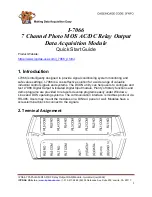
28
DREAM
Layer 0
Layer 1
RTU
1
RTU
7
RTU
5
RTU
3
RTU
9
RTU
2
1
2
9
7
5
3
REPEATER
Detailed information about the
2W RTU system
can be found in the manual “
DREAM 2W
RTU SYSTEM 2007
”.
5.3
Interface for radio communicated RTUs
When remote I/O devices cannot be reached by cable, radio communicated RTUs will be used.
The
RF INTERFACE
will communicate with the
RF RTU
s through an
RF MASTER
receiver/
transmitter located on top of a high pole next to the
RF INTERFACE
. In the field, the
RTU
s
will be placed next to the I/O devices to be controlled. Each
RF RTU
consists of an
RTU BASE
to which the inputs and outputs are tied, and an
RF SLAVE
receiver/ transmitter which will also
be installed on top of a high pole. The
SLAVES
exchange information with the
MASTER
, each
in its appropriate timeslot, dictated by the
RTU’
s address. It is expected that there will be a
clear line of sight between the antenna of the
RF MASTER
and the antennas of the
RF
SLAVES
otherwise some
RF RTU
s can be turned into
REPEATER
s for the benefit of their
neighbors.
Similar to the
2 wired RTU
s, the
RF
RTU
s can read digital and analog inputs and activate
DC
latching outputs and here again there can be several channels of
RF RTU
s with up to 60 RTUs
per channel.
Detailed information about the RF RTU system can be found in the manual “
DREAM RF RTU
GENERATION III IV and IV.V
”.
5.4
Interfaces for local analog inputs
As mentioned above, analog inputs can be read both through the 2W RTU system and the RF
RTU system, however analog sensors located in the close vicinity of the DREAM 2 controller can
Master
Slave
















































